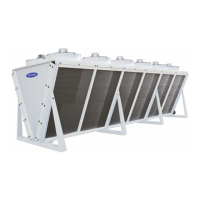Exchanger coils:
The temperature of the uids circulating in the coils must not exceed the value given on the unit's name plate.
It must be below the surface temperature limit (or temperature class) corresponding to the ATEX atmosphere for which the unit is
certied (see labelling).
Electrical connections:
All electrical connections must be performed by qualied, ATEX-approved personnel. Under no circumstances may we be
held liable for the performance of these connections, which are outside the scope of our services.
Prevention of corrosion:
If any rust appears, sand the corroded surface with an emery cloth, clean, then protect with rustproof, anti-electrostatic paint.
19.2 - Periodic inspections/checks
Unit vibration
DANGERS
■ The vibration check detects:
- Any wear to rotating parts. Any signicant discrepancy in the vibration speeds may cause parts to come into contact with each
other, which may spark an explosion; it may even cause certain parts to break with the same result.
- An increase in the vibration speeds may also indicate that there is an accumulation of dust and an imbalance has been created.
An accumulation of dust can spark an explosion, by creating areas of contact or by reducing the ignition temperature of the gas.
CHECK
Users must ensure that the vibration levels of the fan remain below the standardised levels, and that there are no deviations in the
vibration speed values.
Application category BV3 according to standard ISO 14694.
FREQUENCY OF CHECK
Depending on the use (room temperature, and hourly rate of rotation of the device) and the uid circulated (from highly charged with
particles, to very clean), users must check the vibration speeds so that any discrepancy in the speed levels can be detected.
■ The frequency of checks must be as follows:
- Every 150 hours, or weekly, during the rst month of installation.
- Every 2000 hours, or every 3 months thereafter.
CORRECTIVE ACTIONS
If a deviation in the vibration speed values is noted, the fan must be stopped and the impeller inspected. If dust is found, all the areas
affected must be thoroughly cleaned. If the vibration speed level is still compliant with the standardised thresholds, the fan may return
to normal operation.
If the alarm level is reached, schedule a 2
nd
inspection and return to checking every 150 hours, or weekly.
If the maximum standardised vibration thresholds are exceeded, the fan must be stopped, a record must be made,
and a 2
nd
inspection must be performed.
In all cases, a vibration check must be performed after the fan is returned to normal operation.
Checking the ground continuity
DANGERS
■ There is a risk of electrostatic discharge.
19 - SPECIAL INFORMATION FOR ATEX AREAS
24

